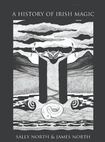
Sally and James North in A History of Irish Magic describe how Madame Blavatsky – co-founder of The Theosophical Society in 1875 – considered Ireland to be a “universal yogic mystery school”.
The Norths write: “Magic [here] generally refers to supernatural phenomena, brought about by specific action, including internal action… and to naturally magical beings such as fairies, magical ancestors, and deities, as well as the belief that the land itself has magical properties and forces.”
Alongside folklore, the Druidic tradition, and the “Celtic Mysteries” revived by WB Yeats, magic here also includes the Irish flowering of occult paths of Hinduism, Buddhism and yoga; Hermeticism; and philosophies and practices of the ancient Near East and Mediterranean associated with the Persian “magi” and Egyptian civilisation.
The book covers the small number of recorded witch accusations and burnings that occurred in Ireland, and several gruesome cases of murder and assault provoked by superstitious belief in fairy possession, including the murder of Bridget Cleary by her husband in 1895. The main reason, the book suggests, that Ireland escaped the mass burnings of the European and British witch craze is because witchcraft was an accepted aspect of Gaelic-influenced culture.
READ MORE
“Magical belief”, write the Norths, “has shaped the course of Irish public affairs throughout recorded history”. Magic was enshrined in Gaelic culture through the Druidic tradition and Brehon Law; and Ireland’s political struggle for self-governance was informed by mysticism, mythology and the cultural renaissance inspired by the Celtic Twilight literary revival.
[ Pilgrim Soul: Readable portrayal of the enigma of WB YeatsOpens in new window ]
James Joyce mocked the “Cultic Toilette”; but he nonetheless adored, along with many other writers, its main proponent: the visionary poet, painter, patron, publisher, journalist, farmers’ rights and co-operative movement organiser, psychic, meditator, and spiritual and cultural revolutionary George Russell, better known by his magical moniker, “AE”. AE was a friend and an inspiration to many Irish freedom fighters, for example, James Connolly, who he met during the 1913 Dublin Lockout and strike while AE was on the ground trying to broker resolution.
A History of Irish Magic provides much to contemplate for those with an interest in Irish occultism, including the assertion that, far from being twee or fringe, magic and magicians have been at the centre of Irish life, hidden in plain sight, for millenniums.
Adrienne Murphy is a freelance critic














